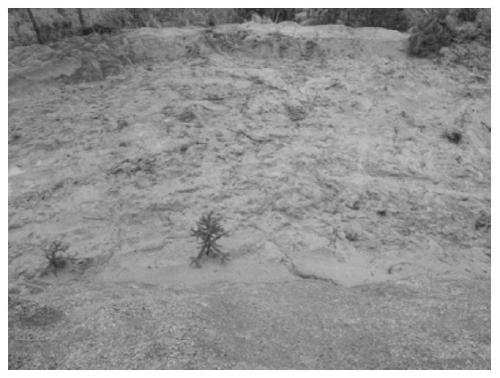Method for repairing rare earth tailings and planting method of morus alba L.
A technology for rare earth tailings and feed mulberry, applied in the field of resources and environment, can solve the problems of poor restoration effect, low soil organic matter content, and low utilization rate of tailings, so as to improve soil fertility, increase added value, and solve soil and water problems. drain effect
- Summary
- Abstract
- Description
- Claims
- Application Information
AI Technical Summary
Problems solved by technology
Method used
Image
Examples
Embodiment 1
[0050] The present embodiment provides a method for repairing rare earth tailings, comprising the following steps:
[0051] (1) Cow dung collection
[0052] Collect cow dung from the cattle farm, and control the drinking water and rainwater for beef cattle breeding from entering the cow dung; among them, the collected cow dung can be treated by cleaning, and at the same time, the cow urine enters the biogas tank for fermentation and the biogas slurry is treated separately.
[0053] (2) Fermentation of cow dung
[0054] The cow dung collected by step (1) is placed in the fermenter, and in the fermenter, vermicompost and navel orange residue are added to ferment, and 13.62kg vermicompost and 8.35kg navel orange residue are added in every 100kg of cow dung, fermented for 3.5 days, Obtain bed bait for cultivating earthworms.
[0055] (3) Breeding earthworms
[0056] The base bed bait that step (2) obtains is placed on the well-drained, shaded ground in strips to obtain the cult...
Embodiment 2
[0066] This embodiment provides a method for repairing rare earth tailings, which is roughly the same as the method in Embodiment 1, except that:
[0067] (1) In the step (2), 15.00 kg of vermicompost and 10.00 kg of navel orange residue were added to every 100 kg of cow dung, and fermented for 3 days to obtain bed bait for cultivating earthworms.
[0068] (2) In step (3), the length of the control earthworm culture base bed is 5m, the width is 0.3m, and the height is 0.3m, and 15kg of earthworms are added in the culture base bed, and the culture base bed is watered every day to make its humidity Keep it at 50-55%, and breed for 20 days; each ton of cow dung produces 13.28±1.52kg of earthworms and 380±14.87kg of vermicompost.
[0069] (3) In step (4), in the rare earth tailings area (east diameter 113 ゜ 54', north latitude 24 ゜ 29', altitude 1020-1030 meters), each horizontal field is ditched to plant feed mulberry, and the ditch is 45 cm wide and 45 cm deep. , The row spacin...
Embodiment 3
[0071] This embodiment provides a method for repairing rare earth tailings, which is roughly the same as the method in Embodiment 1, except that:
[0072] (1) In step (2), 10 kg of vermicompost and 5 kg of navel orange dregs were added to every 100 kg of cow dung, and fermented for 5 days to obtain base bed bait for cultivating earthworms.
[0073] (2) In the step (3), the length of the control earthworm culture base bed is 3m, the width is 0.2m, and the height is 0.2m, and 10kg of earthworms are added in the culture base bed, and the culture base bed is watered every day to make its humidity Keep it at 50-55%, and breed for 25 days; each ton of cow dung produces 12.65±1.21kg of earthworms, and about 370±13.42kg of vermicompost.
[0074] (3) In step (4), in the rare earth tailings area (east diameter 116 ゜ 38, north latitude 27 ゜ 09', altitude 1100-1105 meters), each horizontal field is ditched to plant feed mulberry, and the ditch is 35 cm wide and deep. 45cm, row spacing 0....
PUM
| Property | Measurement | Unit |
|---|---|---|
| Depth | aaaaa | aaaaa |
| Line spacing | aaaaa | aaaaa |
| Plant distance | aaaaa | aaaaa |
Abstract
Description
Claims
Application Information
 Login to View More
Login to View More - R&D
- Intellectual Property
- Life Sciences
- Materials
- Tech Scout
- Unparalleled Data Quality
- Higher Quality Content
- 60% Fewer Hallucinations
Browse by: Latest US Patents, China's latest patents, Technical Efficacy Thesaurus, Application Domain, Technology Topic, Popular Technical Reports.
© 2025 PatSnap. All rights reserved.Legal|Privacy policy|Modern Slavery Act Transparency Statement|Sitemap|About US| Contact US: help@patsnap.com



